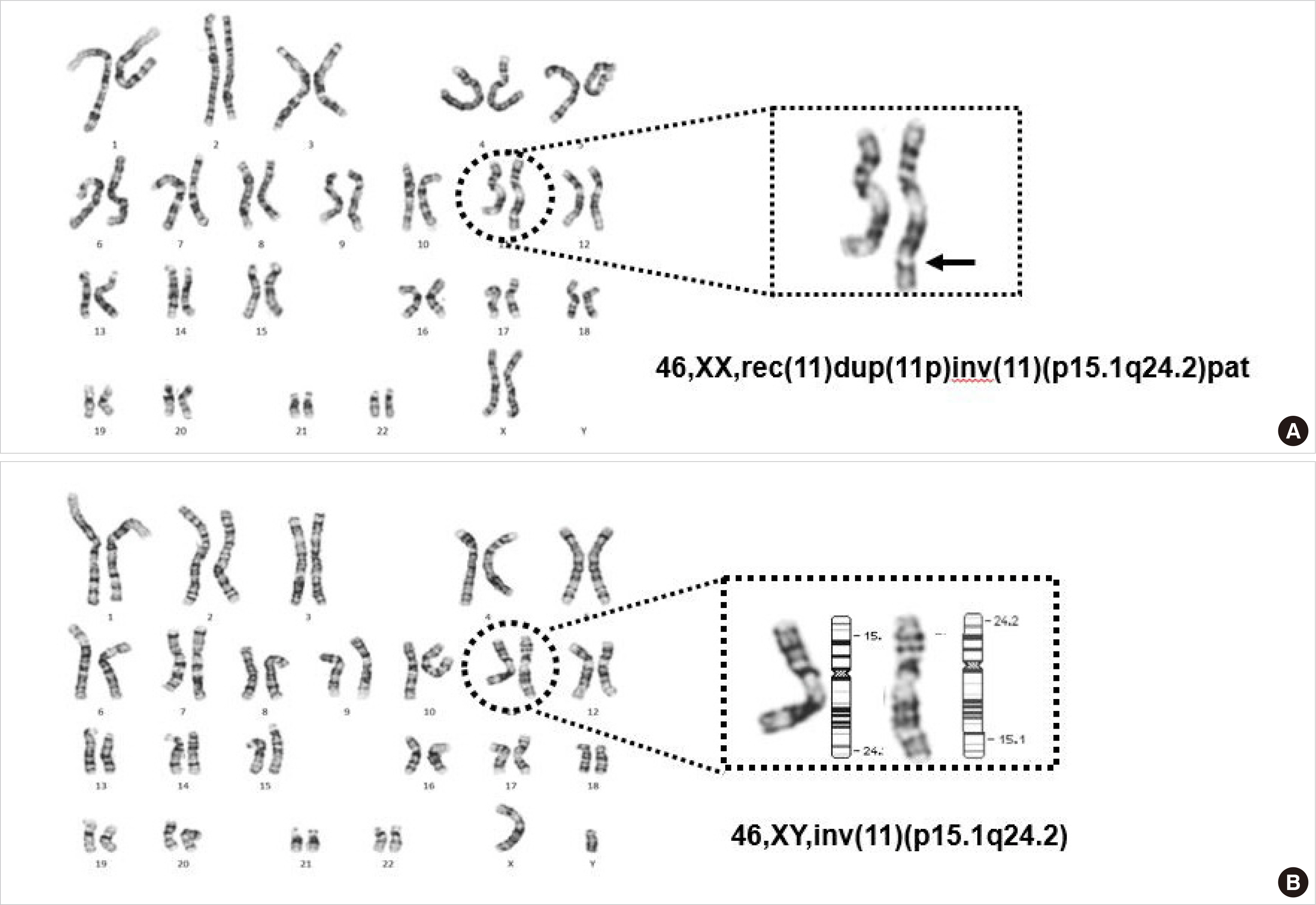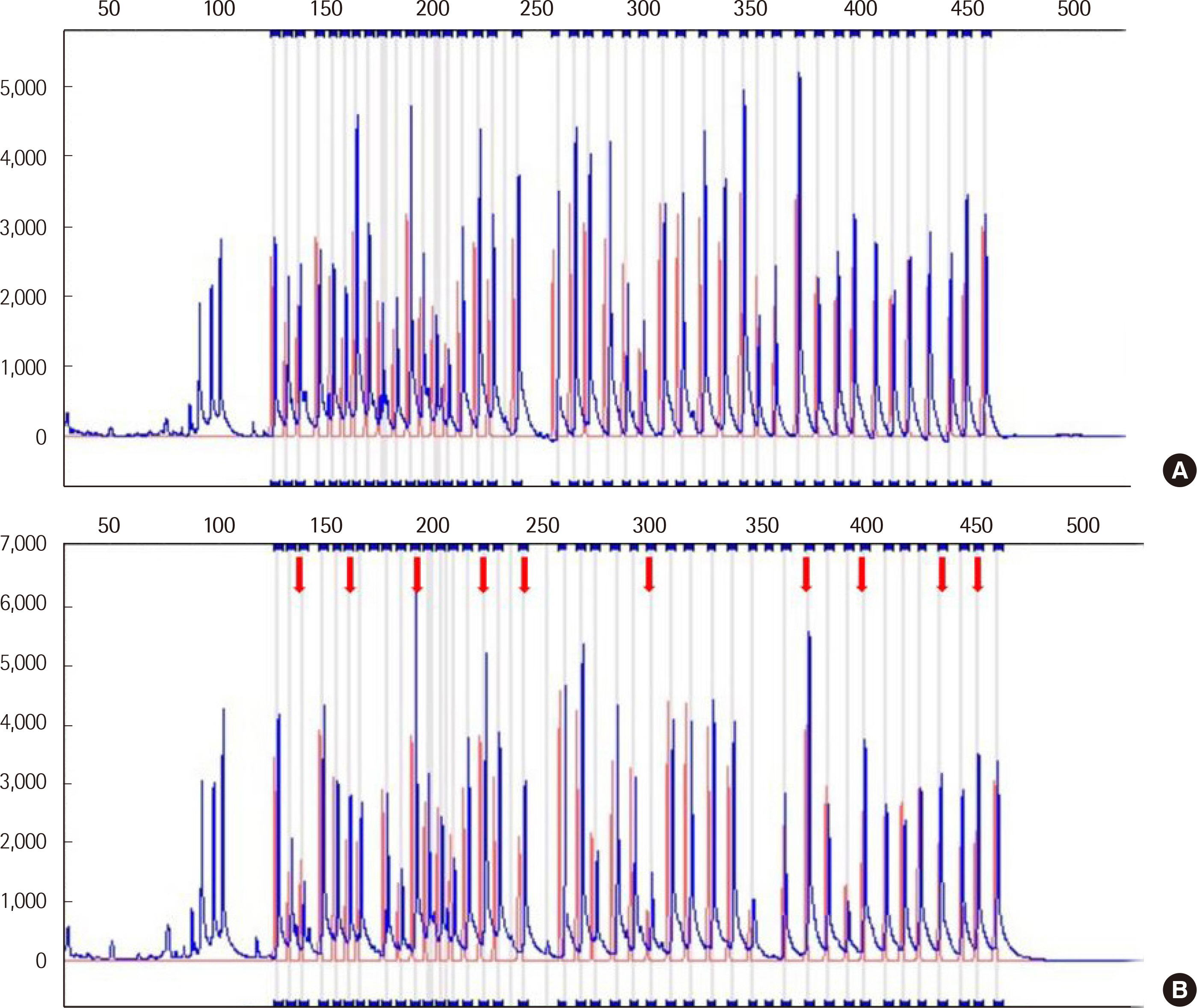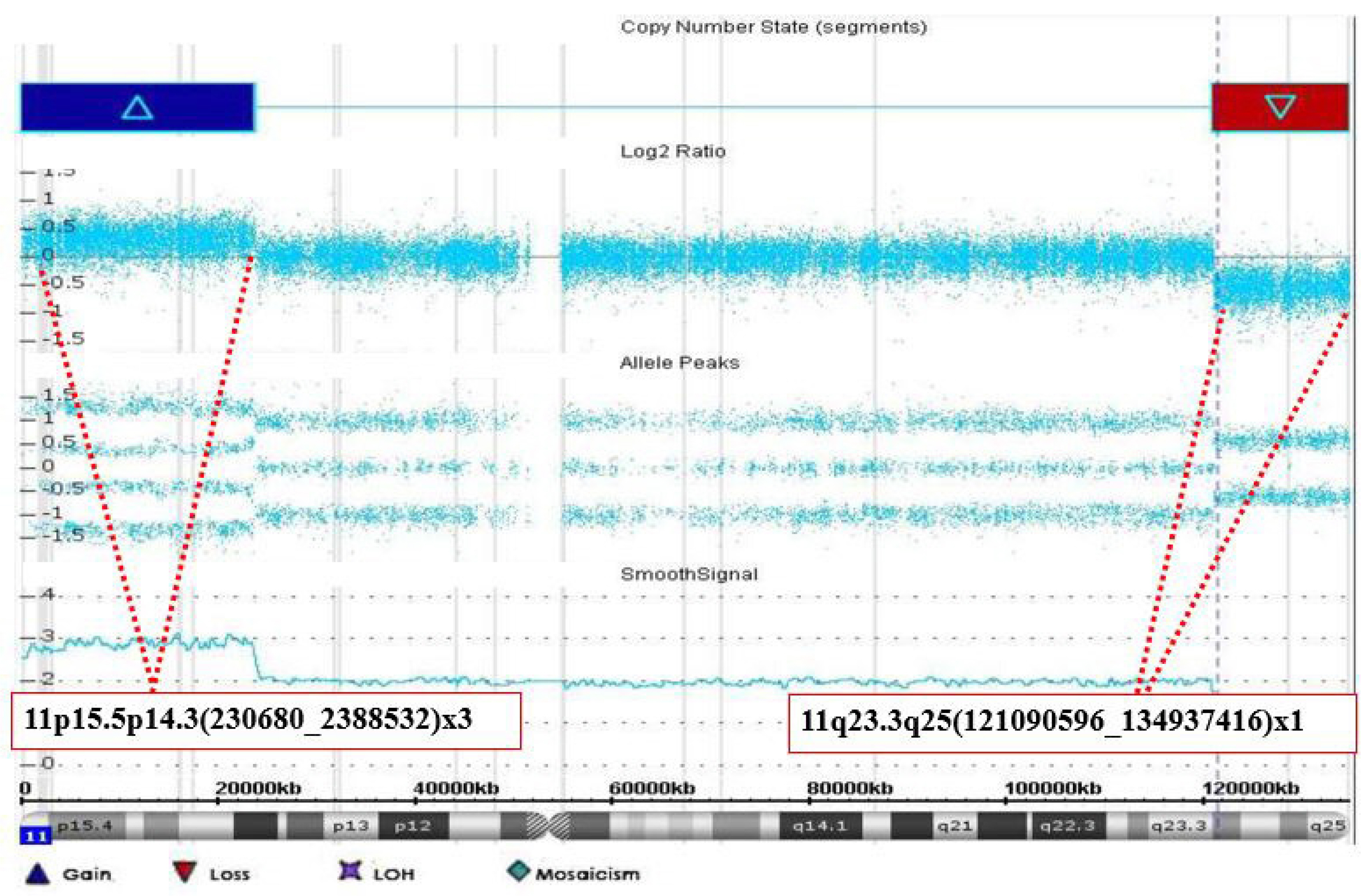Lab Med Online.
2020 Jul;10(3):255-261. 10.3343/lmo.2020.10.3.255.
Beckwith-Wiedemann Syndrome and Jacobsen Syndrome Caused by 11pter Duplication and 11qter Deletion Inherited from Paternal Pericentric Inversion
- Affiliations
-
- 1ent of Laboratory Medicine, University of Ulsan College of Medicine and Asan Medical Center, Seoul, Korea
- 2Medical Genetics Center, Asan Medical Center, Seoul, Korea
- 3Department of Pediatrics, University of Ulsan College of Medicine and Asan Medical Center Children’s Hospital, Seoul, Korea
- KMID: 2504138
- DOI: http://doi.org/10.3343/lmo.2020.10.3.255
Abstract
- We report a case of Beckwith-Wiedemann syndrome (BWS) and Jacobsen syndrome (JBS) due to 11pter trisomy and 11qter monosomy caused by paternal inv(11)(p15.1q24.2). The patient was born premature and had a variety of clinical features including characteristic facial dysmorphism, cardiac abnormalities, and thrombocytopenia. The karyotype was described as 46,XX,rec(11)dup(11p)inv(11)(p15.1q24.2)pat and methylation-specific multiplex ligation-dependent probe amplification analysis showed duplication of the 11p15.5 region and hypermethylation of imprinting center 1. Chromosomal microarray analysis demonstrated 23.8 Mb duplication on 11pter-p14.3 and 13.8 Mb deletion on 11q23.3-qter. These results were consistent with BWS and JBS, respectively. Because uniparental disomy inherited from paternal pericentric inversion results in simultaneous 11p15.5 duplication and 11q23.3 deletion, appropriate genetic tests are necessary for accurate genetic diagnosis of patients.
Keyword
Figure
Reference
-
1. Gardner RJM, Sutherland GR, editors. 2012. Chromosome abnormalities and genetic counseling. 4th ed. Oxford University Press;New York: DOI: 10.1093/med/9780195375336.001.0001.2. Brioude F, Kalish JM, Mussa A, Foster AC, Bliek J, Ferrero GB, et al. 2018; Expert consensus document: Clinical and molecular diagnosis, screening and management of Beckwith-Wiedemann syndrome: an international consensus statement. Nat Rev Endocrinol. 14:229–49. DOI: 10.1038/nrendo.2017.166. PMID: 29377879. PMCID: PMC6022848.3. Choufani S, Shuman C, Weksberg R. 2010; Beckwith-Wiedemann syndrome. Am J Med Genet C Semin Med Genet. 154C:343–54. DOI: 10.1002/ajmg.c.30267. PMID: 20803657.
Article4. Weksberg R, Shuman C, Beckwith JB. 2010; Beckwith-Wiedemann syndrome. Eur J Hum Genet. 18:8–14. DOI: 10.1038/ejhg.2009.106. PMID: 19550435. PMCID: PMC2987155.
Article5. Grossfeld PD, Mattina T, Lai Z, Favier R, Jones KL, Cotter F, et al. 2004; The 11q terminal deletion disorder: a prospective study of 110 cases. Am J Med Genet A. 129A:51–61. DOI: 10.1002/ajmg.a.30090. PMID: 15266616.
Article6. Mattina T, Perrotta CS, Grossfeld P. 2009; Jacobsen syndrome. Orphanet J Rare Dis. 4:9. DOI: 10.1186/1750-1172-4-9. PMID: 19267933. PMCID: PMC2670819.
Article7. Murrell A, Heeson S, Cooper WN, Douglas E, Apostolidou S, Moore GE, et al. 2004; An association between variants in the IGF2 gene and Beckwith-Wiedemann syndrome: interaction between genotype and epigenotype. Hum Mol Genet. 13:247–55. DOI: 10.1093/hmg/ddh013. PMID: 14645199.8. Poole RL, Leith DJ, Docherty LE, Shmela ME, Gicquel C, Splitt M, et al. 2012; Beckwith-Wiedemann syndrome caused by maternally inherited mutation of an OCT-binding motif in the IGF2/H19-imprinting control region, ICR1. Eur J Hum Genet. 20:240–3. DOI: 10.1038/ejhg.2011.166. PMID: 21863054. PMCID: PMC3260935.
Article9. Favier R, Akshoomoff N, Mattson S, Grossfeld P. 2015; Jacobsen syndrome:Advances in our knowledge of phenotype and genotype. Am J Med Genet C Semin Med Genet. 169:239–50. DOI: 10.1002/ajmg.c.31448. PMID: 26285164.10. Tyson C, Qiao Y, Harvard C, Liu X, Bernier FP, McGillivray B, et al. 2008; Submicroscopic deletions of 11q24-25 in individuals without Jacobsen syndrome: re-examination of the critical region by high-resolution array-CGH. Mol Cytogenet. 1:23. DOI: 10.1186/1755-8166-1-23. PMID: 19000322. PMCID: PMC2648978.
Article11. Wenger SL, Grossfeld PD, Siu BL, Coad JE, Keller FG, Hummel M. 2006; Molecular characterization of an 11q interstitial deletion in a patient with the clinical features of Jacobsen syndrome. Am J Med Genet A. 140:704–8. DOI: 10.1002/ajmg.a.31146. PMID: 16502431.
Article12. Gadzicki D, Baumer A, Wey E, Happel CM, Rudolph C, Tönnies H, et al. 2006; Jacobsen syndrome and Beckwith-Wiedemann syndrome caused by a parental pericentric inversion inv(11)(p15q24). Ann Hum Genet. 70:958–64. DOI: 10.1111/j.1469-1809.2006.00271.x. PMID: 17044870.
Article13. Putoux A, Labalme A, André JM, Till M, Schluth-Bolard C, Berard J, et al. 2013; Jacobsen and Beckwith-Wiedemann syndromes in a child with mosaicism for partial 11pter trisomy and partial 11qter monosomy. Am J Med Genet A. 161A:331–7. DOI: 10.1002/ajmg.a.35708. PMID: 23322614.
Article




